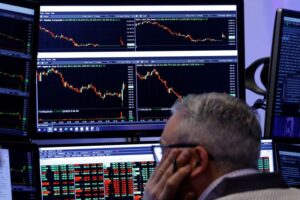Market Insights: Navigating Geopolitics and Economic Concerns
As we step into a new trading day, investors are grappling with an overshadowing mix of geopolitical tensions and emerging worries about the U.S. economy. This week, sentiments on Wall Street reflect a cautious perspective as turbulent news headlines dominate the narrative.
Wall Street’s Reaction to Geopolitical Tensions
The geopolitical landscape remains fraught, with various international issues attracting attention. However, the most pressing concern for investors is the creeping anxiety regarding a potential slowdown in the U.S. economy. Following turbulent market signals, the S&P 500 index recently fell below the 6,000-mark for the first time in three weeks. Notably, the tech-heavy Nasdaq and small-cap Russell 2000 indexes have also turned negative for the year.
Investor attention is particularly focused on tech giant Nvidia as it approaches a crucial earnings report. This uncertainty is influencing market behavior negatively, as shown by the S&P 500 experiencing only a modest gain of 1% so far this year—a stark contrast to the robust 13% increase seen in Germany’s blue-chip DAX index after favorable election outcomes and fiscal easing hopes.
Fear on the Rise: The VIX Index
The volatility index, or VIX, which measures market risk, spiked above 20 for the first time since early February, indicating that investors are increasingly uneasy about potential disruptions in the market. This indicates a paradigm shift where investors are beginning to price in greater uncertainty and risk associated with equity holdings.
China and U.S. Trade Policy: The Impact on Markets
Adding to the market jitters, China’s stock market saw losses exceeding 1% following reports of the Trump administration potentially tightening chip restrictions on Beijing. These restrictions aim to stymie China’s technological advancements and echo previous initiatives by the Biden administration.
Trade tensions are not only brewing internationally but also domestically. Trump reaffirmed that tariffs on imports from Canada and Mexico remain “on time and on schedule,” despite diplomatic maneuvers on issues like border security and fentanyl trafficking. These policies further contribute to investor anxiety, as they create uncertainty surrounding future trade dynamics.
Economic Indicators Paint a Gloomy Picture
This week, economic indicators suggest a troubling trend in various aspects of the U.S. economy. Retail sales figures have failed to meet expectations, while recent surveys indicate that the service sector—the backbone of the U.S. economy—is contracting for the first time in two years. The latest data from the Dallas and Chicago Federal Reserve surveys corroborate a narrative of slowing economic activity.
Consumer confidence is also on shaky ground. The University of Michigan’s latest household survey reported a decline to 15-month lows, indicating a downturn in consumer sentiment. Eyes are set on the Conference Board’s consumer sentiment report, which could further illuminate the state of American consumer behavior during this tumultuous period.
Investments and Treasury Yields: What to Expect?
Given the adverse economic landscape, some investors are seeking refuge in U.S. Treasury bonds, leading to a notable decline in yields. Ten-year Treasury rates have plummeted to 4.33%, while two-year yields dropped to their lowest points since December. Meanwhile, futures markets have begun to price in potential interest rate cuts by the Federal Reserve, signaling growing concerns about economic resilience.
Interestingly, despite these challenges, the U.S. dollar has remained surprisingly stable. It is affected by the interplay of domestic economic struggles and the looming threat of increased tariffs, coupled with fluctuating yields.
Global Perspective: Europe and Defense Spending
Amidst U.S. market turmoil, European markets have displayed resilience. The STOXX 600 index experienced a 0.3% gain, buoyed by attractive valuations and fiscal optimism following the German elections. However, fears of a chaotic resolution to the ongoing Ukraine crisis have sparked a renewed emphasis on defense spending across Europe, with Germany reportedly contemplating a significant emergency fund.
Looking Ahead
Key developments to keep an eye on include:
- The release of the U.S. Conference Board’s consumer confidence survey and Richmond Federal Reserve’s business surveys.
- An important day for U.S. corporate earnings with reports coming from notable companies like Home Depot, First Solar, and Intuit.
- A significant U.S. Treasury auction of $70 billion in five-year notes.
As we navigate these uncertain waters, staying informed and agile is paramount. The changes in political landscapes, economic indicators, and consumer sentiments could drastically influence investment strategies in the weeks ahead. Monitoring these trends with diligence will empower investors to make well-informed decisions in a fluctuating environment.
This backdrop highlights just how critical it is for investors to remain strategic, assessing both risks and opportunities in trying to weather the storm ahead.

